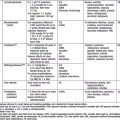Chapter 227 Cryptococcus neoformans
Clinical Manifestations
Bicanic T, Meintjes G, Rebe K, et al. Immune reconstitution inflammatory syndrome in HIV-associated cryptococcal meningitis: a prospective study. J Acquir Immune Defic Syndr. 2009;51:130-134.
Chang WC, Tzao C, Hsu HH, et al. Pulmonary cryptococcosis: comparison of clinical and radiographic characteristics in immunocompetent and immunocompromised patients. Chest. 2006;129(2):333-340.
Chayakulkeeree M, Perfect JR. Cryptococcosis. Infect Dis Clin of North Am. 2006;20:507-544.
Goldman DL, Khine H, Abadi J, et al. Serologic evidence for Cryptococcus neoformans infection in early childhood. Pediatrics. 2001;107(5):E66.
Gonzalez CE, Shetty D, Lewis LL, et al. Cryptococcus in human immunodeficiency virus–infected children. Pediatr Infect Dis J. 1996;15:796-800.
Gumbo T, Kadzirange G, Mielke J, et al. Cryptococcus neoformans meningoencephalitis in African children with acquired immunodeficiency syndrome. Pediatr Infect Dis J. 2002;21:54-57.
Leggiadro RJ, Barrett FF, Hughes WT. Extrapulmonary cryptococcosis in immunocompromised infants and children. Pediatr Infect Dis J. 1992;11:43-47.
Leggiadro RJ, Kline MW, Hughes WT. Extrapulmonary cryptococcosis in children with acquired immunodeficiency syndrome. Pediatr Infect Dis J. 1991;10:658-662.
Moncino MD, Gutman LT. Severe systemic cryptococcal disease in a child: review of prognostic indicators predicting treatment failure and an approach to maintenance therapy with oral fluconazole. Pediatr Infect Dis J. 1990;9:363-368.
Perfect JR, Casadevall A. Cryptococcosis. Infect Dis Clin North Am. 2002;16:837-874.
Perfect JR, Dismukes WE, Dromer F, et al. Clinical practice guidelines for the management of cryptococcal disease: 2010 update by the Infectious Diseases Society of America. Clin Infect Dis. 2010;50:291-322.
Saag MS, Graybill RJ, Larsen RA, et al. Practice guidelines for the management of cryptococcal disease. Clin Infect Dis. 2000;30:710-718.
Singh N, Alexander BD, Lortholary O, et al. Cryptococcus neoformans in organ transplant recipients: impact of calcineurin-inhibitor agents on mortality. J Infect Dis. 2007;195:756-764.
Speed BR, Kaldor J. Rarity of cryptococcal infection in children. Pediatr Infect Dis J. 1997;16:536-537.
Sun HY, Alexander BD, Lortholary O, et al. Lipid formulations of amphotericin B significantly improve outcome in solid organ transplant recipients with central nervous system cryptococcosis. Clin Infect Dis. 2009;49:1721-1728.
Sweeney DA, Caserta MT, Korones DN, et al. A ten-year-old boy with a pulmonary nodule secondary to Cryptococcus neoformans: case report and review of the literature. Pediatr Infect Dis J. 2003;2:1089-1093.




